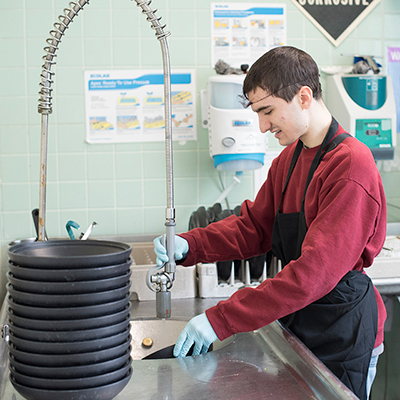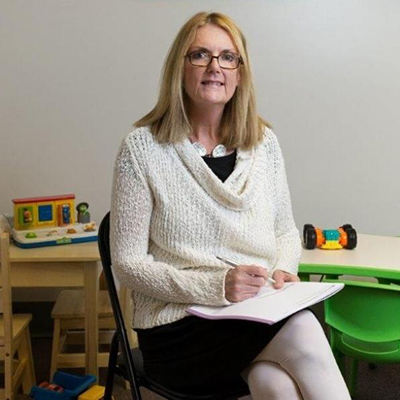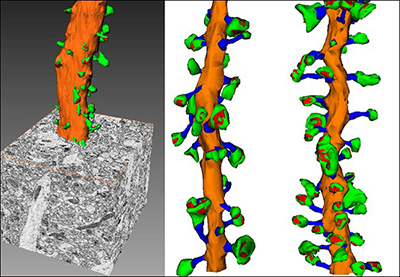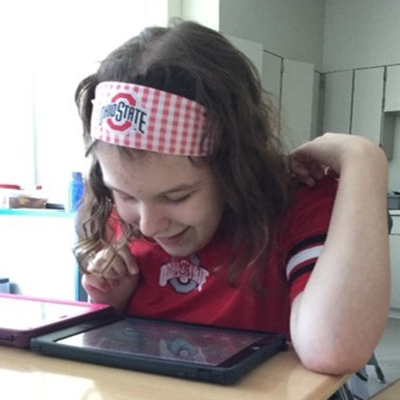Gift Benefits Autism Vocational Training Program

Each year, about 1 in 68 children is identified with autism spectrum disorder (ASD), according to the Centers for Disease Control and Prevention. The neurodevelopmental disorder affects communication, socialization and behavior. ASD occurs in all racial, ethnic, and socioeconomic groups.
But what happens when children with autism become adults with autism?
National data shows that nearly half of young adults with autism do not work for pay upon leaving school, and those who do tend to have part-time, low-wage jobs. Work experience is consistently identified as the most important predictor of post-school employment success for students with disabilities.
Program Explores Employment Opportunities
To address the critical need for work experience, Cleveland Clinic Children’s Center for Autism Vocational Training Program, part of the Lerner School for Autism, provides on-the-job career training internships for its students. Courtney Gebura, Transition Coordinator at the school, says the program’s goal is to send students into the community to perform volunteer work, allowing them to gain job skills and experience and become productive members of society after graduation.
“We try to get our students ages 16 to 22 out in the community as much as possible to get job training in a variety of tasks that could turn into a part-time or full-time position,” she says. “Some will need more support than others. While not all of our students are able to maintain a part-time or full-time position, they may be able to work in a more supportive environment.”
Ms. Gebura says the program places students with a number of different employers throughout the Cleveland metropolitan area. “We have a warehouse training site, a dish room site, a food production site, clerical training, and a farm setting,” she says. “Having a variety of employers is really nice because it allows the students to discover what they like and don’t like about certain jobs.” A Center for Autism job coach accompanies each student to ensure that assignments are successfully and efficiently completed.
Because the school is in an urban area, reliable transportation to job sites is important. The 22 participants in the vocational program currently share nine vehicles with the entire student body at the Lerner School for Autism.
“Some of our employers are 15 to 30 miles away,” Gebura says. “One of the biggest challenges in finding more employers is the logistics of actually getting our students to the sites.”

A Good Fit for Philanthropic Goals
The Louise H. and David S. Ingalls Foundation, based in Shaker Heights, Ohio, has supported autism research at Cleveland Clinic and was considering making another gift. Bobbie Brown, PhD, president of the organization and a granddaughter of the founders, was particularly interested in helping older children because her nephew, who is in his 20s, has Asperger syndrome, a subtype of ASD generally considered to be on the high-functioning end of the spectrum.
“Sometimes I almost forget that he has it until he’s a little more anxious or just doesn’t have confidence,” Dr. Brown says. “Even though these high-functioning individuals are so smart, they still have autism that can affect their confidence and their ability to lead a meaningful and purposeful life.”
The Ingalls Foundation also helps fund many of the Lerner School for Autism’s employer training sites, so it made sense to provide resources for purchasing a passenger van to take students to job sites. “We want to focus on helping young adults,” Dr. Brown says. “Once they’re out of school, what do they do? Do they live in a group home, stay home with their parents, or maybe live independently? These kids want to be responsible and job training is a good incentive to encourage independence.”
“Ohio is really pushing to get young adults with autism employed and out in the community, and this new van will help us bring awareness to different employers,” she says. “Our students have these great abilities, and maybe they’re a little bit different, but those differences may actually benefit your business.”
How You Can Help
Cleveland Clinic is a nonprofit hospital and your support, no matter the amount, makes a difference in the lives of our patients and their families.
New Leader at Center for Autism

A highly regarded early childhood scholar who has focused her career on autism spectrum disorder (ASD) will assume the role of Director, Cleveland Clinic Children’s Center for Autism, in June.
Cynthia Rheney Johnson, PhD, BCBA-D, will have responsibility for clinical supervision, clinical training, program development, research and departmental administration. “I have experience in all these areas, so I know I can bring some efficiency to the role,” she says. “But what I’m really looking forward to is energizing the team around all aspects of autism prevention, treatment and care. I feel truly privileged to be joining this already very committed group of people.”
One of Dr. Johnson’s first priorities will be to assess the needs and interests of the community with respect to autism. “I anticipate we may want to expand some service lines,” she says. She also plans to continue working with colleagues across the country to ensure that autism interventions and care will continue to be effective.
“We need to ask ourselves how we can use new technologies to benefit families of autism,” she says. “How can we ensure, for instance, that real-time stress management techniques are delivered on mobile platforms as effectively as they are in person?”
Considerable gains have been made in all levels of autism research over the past two decades, Dr. Johnson notes, but there also is much opportunity for improvement.
“I think we can do better with intervention and support to the family,” she says. “I’m encouraged when I see families wanting to learn, and patients becoming productive individuals. There is a lot of family advocacy in the population we serve, which helps keep us motivated and working hard.”
Research Interests
Dr. Johnson, a board-certified behavior analyst, currently is a faculty member in the Department of Clinical and Health Psychology at the University of Florida. Before that, she was Director of the Autism Center at Children’s Hospital of Pittsburgh of UPMC for 15 years. She earned her doctorate at the University of South Carolina and completed a postdoctoral fellowship at the Johns Hopkins School of Medicine.
Over the course of her career, Dr. Johnson has led or participated in dozens of research projects and clinical trials. She recently was awarded a $1 million grant by the Department of Defense Office of Congressionally Directed Medical Research Programs for a four-year study of the effectiveness of sleep intervention delivered via a telehealth platform for young children with autism.
“I always knew I wanted to work with children, particularly young children,” Dr. Johnson says. “In graduate school, I conducted evaluations for a school district and became very aware of and interested in children with autism and developmental disabilities. From that point on, it’s been my focus.”
How You Can Help
At Cleveland Clinic Children’s, we believe that every one of us has the power to make a difference — we hope you will join us in rising to the challenge. Make a gift today to support patient care and groundbreaking research.
Synaptic Pruning May Be Key to Autism Spectrum Disorders

Difficulty communicating is one of the symptoms most commonly associated with autism spectrum disorders (ASD).
The developmental disorders also are characterized by restrictive and repetitive behaviors and trouble interacting with and relating to others. These symptoms begin to present as a child’s brain develops during the first few years of life.
Interestingly, impaired communication may not be just an effect of the disorders but also what causes them, according to Cleveland Clinic researchers.
Technology Aids in Discovery
Neurons are nerve cells found in the brain that receive, process and transmit signals. Cleveland Clinic researchers have discovered for the first time that faulty connections and communication between neurons causes fragile X syndrome (FXS), the leading inherited cause of intellectual disability and autism spectrum disorders.
The researchers, led by Bruce Trapp, PhD, Chair of Neurosciences in the Lerner Research Institute, used 3-D electron microscopy, which is far more sensitive than traditional light microscopy and allows nanoscale visualization, to characterize neurons in pre-clinical models. They looked specifically at dendritic spines, which are the branch-like extensions of neurons that receive signals from neighboring cells, like a socket that connects with an electrical plug.
Examining Dendritic Spines

With this technology, Dr. Trapp’s team closely examined the size and shape of dendritic spines found in the brains of their pre-clinical models. They discovered that the FXS brains had more dendritic spines than the healthy brains. There also appeared to be fewer mature dendritic spines.
The researchers went on to show that this change was caused by disrupted “housekeeping” of nerve cells that occurs in early brain development—called synaptic pruning. “Synaptic pruning removes faulty or immature nerve cell connections in the young brain,” says Dr. Trapp, who holds The Morris R. and Ruth V. Graham Endowed Chair in Biomedical Research. “When this process malfunctions, nerve cells are not able to receive signals properly.”
Hope for Restoring Cognitive Abilities
This groundbreaking research identifies the space between neurons, called synapses, as an area of interest for ASD researchers. It suggests that enhancing synaptic pruning may help restore some cognitive abilities in patients with these disorders. Further study may explore how to engineer the proper number and maturation of dendritic spines and how this affects disease progression and severity.
With 1 percent of the world’s population and 1 in 68 newborns in the United States affected by autism, the clinical need for better neurological and genetic understanding of the diseases is certainly great, and urgent. This leading-edge imaging research brings us ever closer.
How You Can Help
Your gift in support of autism research can help accelerate scientific findings like Dr. Trapp’s.
Lerner School Marks 10 Years of Life-changing Education
| Tanya, 13, is in the Lerner School’s intermediate 1 classroom. Since starting at the school in 2016, she has learned to use an iPad to communicate. She surprised her parents this past Christmas by adding pictures to it by herself to show them which toys she wanted. She also participates in community outings with her class, and, last summer, took her first overnight trip with her parents to attend her brother’s sporting event. |  |
Tanya is among 320 students from 31 school districts who have attended the Lerner School in Cleveland Clinic’s Center for Autism since it opened 10 years ago.
The chartered, private day school, launched with philanthropic support from Norma Lerner and Mort and Iris November, is certified by the state of Ohio and serves students from diagnosis to age 22. Before the school opened, students were taught in a small classroom within Cleveland Clinic’s Hospital for Rehabilitation. In 2008, with a growing student population, the program was moved into a new addition adjacent to that site and named the Lerner School for Autism. Classes are held in the Debra Ann November Wing.
In 2015, another preschool classroom was added to accommodate growing early intervention needs. Currently, 100 students are enrolled at the school -- 70 school-age and 30 preschool students. For students approaching graduation, the Lerner School focuses on adult transition and partners with job-training sites.
“We continuously strive to expand and improve the services we provide our students at the Lerner School,” says Allison Benedict, school administrator, who has been with the school for 15 years. “In Early Childhood, we’ve developed a reverse inclusion program where neuro-typical peers attend our school. In the upper school, we’ve expanded our vocational training program and we currently partner with nine different vocational sites.”
The school’s educational program emphasizes research-based autism intervention stemming from the philosophy and interventional techniques of Applied Behavior Analysis (ABA). It is a full-day, year-round program, with strong parental involvement, low student-to-staff ratio, highly individualized programs and tiered levels of instruction.
Looking to the school’s future goals, Ms. Benedict says, “We’d like to continue our mission of empowering individuals with autism and their families in achieving their fullest potential.”

